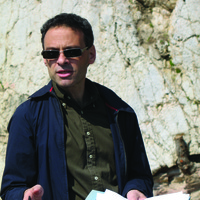Papers by STAVROS PASPALAS

BRILL eBooks, 2011
This chapter introduces the wider scholarly community a range of important, recently discovered o... more This chapter introduces the wider scholarly community a range of important, recently discovered objects relevant to the cultural life of pre-Hellenistic Macedonia. It focuses on the years 479-323 BC, the "Classical period", an analytical unit not without relevance to Macedonian history, though there will also be reference to the links between art in this period and in the late "Archaic" period. Of the major arts it is sculpture which is first evident in Macedonia, and specifically from funerary contexts. The late Archaic sculptures from Aiane do not stand alone. Most of the known fifth-century sculpture from Macedonia is funerary. The preserved paintings from Macedonia all belong to the funerary sphere. "Art", also includes categories which are often included under the rubric "minor arts". An examination of the terracotta figurines, excavated primarily in funerary contexts, from Macedonia offers insights into the development of another field of the "minor arts". Keywords: classical art; late Archaic sculptures; minor arts; monumental paintings; pre-Hellenistic Macedonia
A Companion to the Achaemenid Persian Empire
Antiquity
Recent archaeological survey on the Greek island of Kythera yielded prehistoric quartz that offer... more Recent archaeological survey on the Greek island of Kythera yielded prehistoric quartz that offers new information on the island's role in early Aegean occupation.
Smith/A Companion to Greek Art, 2012
The Encyclopedia of Ancient History, 2012
The Encyclopedia of Ancient History, 2012
The Encyclopedia of Ancient History, 2012
The Encyclopedia of Ancient History, 2012
The icon of the Myrtidiotissa ("Our Lady of the Myrtle") has been the palladium of the island of ... more The icon of the Myrtidiotissa ("Our Lady of the Myrtle") has been the palladium of the island of Kythera at least from the 17th century. A series of wondrous events have been attributed to its miraculous powers, and the tales told about it reveal that it has played a central role in the creation ofthe islanders' identity. The icon can be classified as belonging to the well-known "Hodegetria" type, though its most arresting characteristic, at least for the past few centuries, is that the Virgin and the Christ-Child have featureless, black faces. Mass-produced copies ofthis icon may date back to at least the mid-l8th century. This paper looks at how these representations have changed, how the odd facelessness ofthe two figures (in the context ofthe iconography of the wider Orthodox world) has been dealt with, and how the particularity of this
Ancient West & East, Volume 5, Jan 1, 2006
In the late 6th and early 5th century BC the north-western Aegean was populated by a number of di... more In the late 6th and early 5th century BC the north-western Aegean was populated by a number of different peoples organised into various polities, but they all came under the domination of the Achaemenid empire for a few short decades. It was from this region too that Alexander set out to conquer the East. The present paper examines the nature of the links between the Macedonian kingdom and the poleis of the region with the empire. It focuses on a number of case studies which deal critically with recently excavated finds as well as already known material. The region is shown to have had a relationship with the Achaemenid sphere that changed through time, and while it was truly on the imperial margins there was still ground for fertile interactions between the Achaemenid centre and the smaller centres of this outlying area.
Archaeology and history in Roman, medieval and …, Jan 1, 2008
Page 221. Chapter 12 The Panagia Myrtidiotissa: The Changing Image of a Kytherian Icon Stavros A.... more Page 221. Chapter 12 The Panagia Myrtidiotissa: The Changing Image of a Kytherian Icon Stavros A. Paspalas Abstract The icon of the Myrtidiotissa (" Our Lady of the Myrtle") has been the palladium of the island of Kythera at least from the 17th century. ...











Uploads
Papers by STAVROS PASPALAS